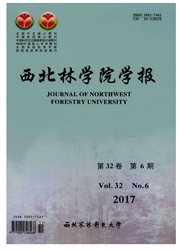

 中文摘要:
中文摘要:
植被模式在在干旱、半干旱的区域的地球表面水文学过程的规定是重要的。模仿实验室的降雨实验在黄土高原上在土壤侵蚀和 Dryland 耕作的国家重点实验室被使用, Yangling,西北的中国,确定流量和土壤损失上的 Artemisia capillaris 模式的效果。在流量 / 沉积产量和植被参数之间的量的关系彻底地也为在土壤侵蚀上识别植被的减小机制用路径分析方法被分析。没有植被(C0 ) 并且在另外的三个不同植被分发模式上, 90 mm/h 的模仿的降雨紧张在一个控制阴谋上被使用:一个棋盘模式(CP ) ,对斜坡方向(BP ) 垂直的一个 banded 模式,和一个单身者长剥去平行到斜坡方向(LP ) 。每个有图案的阴谋收到了实验的二个集合,即未经触动的植物和根仅仅分别地。所有处理有三复制。结果显示出那 A 的所有三个另外的不同模式(CP, BP 和 LP ) 。capillaris 能有效地减少流量和沉积产量。与 C0 相比,另外的三个未经触动的植物阴谋有 12%25% 更少流量和 58%-92% 更少沉积。根贡献了更多到沉积减小(46%70%) ,而射击贡献了更多到流量减小(57%81%) 。BP 和 CP 与 LP 相比在土壤侵蚀上展出了更好的控制效果。路径分析显示那个根长度密度和植物数字是影响流量率的关键参数,当根表面区域密度和根重量密度是影响沉积率的中央指示物时。结果显示播种密度的适当增加在保存土壤和水有实际意义。
 英文摘要:
英文摘要:
Vegetation patterns are important in the regulation of earth surface hydrological processes in arid and semi-arid areas. Laboratory-simulated rainfall experiments were used at the State Key Laboratory of Soil Erosion and Dryland Farming on the Loess Plateau, Yangling, northwestern China, to quantify the effects of Artemisia capillaris patterns on runoff and soil loss. The quantitative relationships between runoff/sediment yield and vegetation parameters were also thoroughly analyzed using the path analysis method for identifying the reduction mechanism of vegetation on soil erosion. A simulated rainfall intensity of 90 mm/h was applied on a control plot without vegetation (Co) and on the other three different vegetation distribution patterns: a checkerboard pattern (CP), a banded pattern perpendicular to the slope direction (BP), and a single long strip parallel to the slope direction (LP). Each patterned plot received two sets of experiments, i.e. intact plants and roots only, respectively. All treatments had three replicates. The results showed that all the three other different patterns (CP, BP and LP) of A. capillaris could effectively reduce the runoff and sediment yield. Compared with Co, the other three intact plant plots had a 12%-25% less runoff and 58%-92% less sediment. Roots contributed more to sediment reduction (46%-70%), whereas shoots contributed more to runoff reduction (57%-81%). BP and CP exhibited preferable controlling effects on soil erosion compared with LP. Path analysis indicated that root length density and plant number were key parameters influencing runoff rate, while root surface area density and root weight density were central indicators affecting sediment rate. The results indicated that an appropriate increase of sowing density has practical significance in conserving soil and water.
 同期刊论文项目
同期刊论文项目
 同项目期刊论文
同项目期刊论文
 Effects of Revegetation on Soil Microbial Biomass, Enzyme Activities, and Nutrient Cycling on the Lo
Effects of Revegetation on Soil Microbial Biomass, Enzyme Activities, and Nutrient Cycling on the Lo Phytogenic mounds of four typical shoot architecture species at different slope gradients on the Loe
Phytogenic mounds of four typical shoot architecture species at different slope gradients on the Loe The efficiency of large-scale afforestation with fish-scale pits for revegetation and soil erosion c
The efficiency of large-scale afforestation with fish-scale pits for revegetation and soil erosion c The role of local species pool, soil seed bank and seedling pool in natural vegetation restoration o
The role of local species pool, soil seed bank and seedling pool in natural vegetation restoration o Soil organic carbon distribution under different land uses and landscape positions in two typical wa
Soil organic carbon distribution under different land uses and landscape positions in two typical wa Can seed removal through soil erosion explain the scarcity of vegetation in the Chinese Loess Platea
Can seed removal through soil erosion explain the scarcity of vegetation in the Chinese Loess Platea Soil Thresholds for Classification of Vegetation Types in Abandoned Cropland on the Loess Plateau, C
Soil Thresholds for Classification of Vegetation Types in Abandoned Cropland on the Loess Plateau, C Influence of vegetation parameters on runoff and sediment characteristics in patterned Artemisia cap
Influence of vegetation parameters on runoff and sediment characteristics in patterned Artemisia cap Revegetation as an efficient means of increasing soil aggregate stability on the Loess Plateau (Chin
Revegetation as an efficient means of increasing soil aggregate stability on the Loess Plateau (Chin Effects of seed morphology on seed removal and plant distribution in the Chinese hill-gully Loess Pl
Effects of seed morphology on seed removal and plant distribution in the Chinese hill-gully Loess Pl Soil organic carbon distribution in relation to land use and its storage in a small watershed of the
Soil organic carbon distribution in relation to land use and its storage in a small watershed of the Changes in soil properties across a chronosequence of vegetation restoration on the Loess Plateau of
Changes in soil properties across a chronosequence of vegetation restoration on the Loess Plateau of 期刊信息
期刊信息
